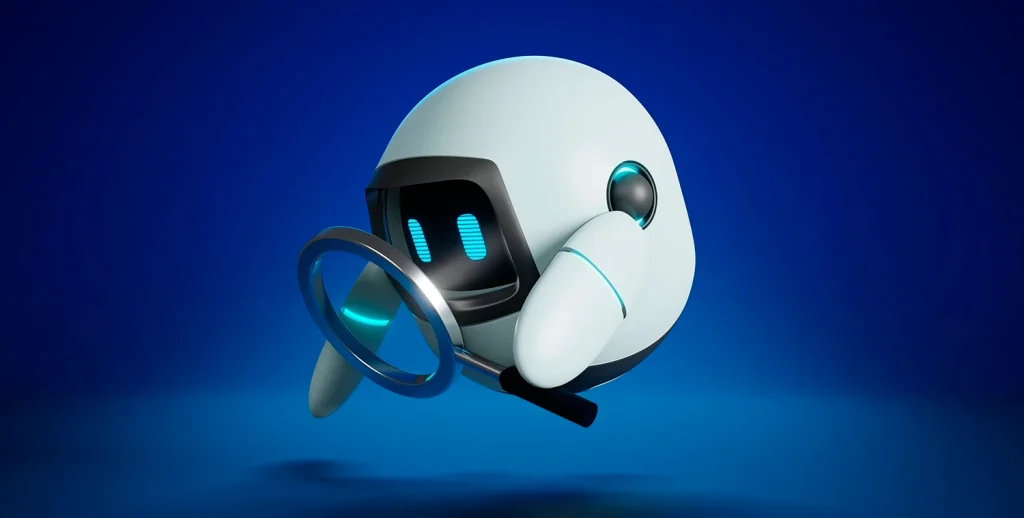We use cookies to ensure we give you the best experience on our website. By clicking Agree you accept our Privacy and Cookies Policy.
Can Chat GPT be detected?

Valerii Bunchuk
Author

February 4, 2025
Date

 16 minutes read
16 minutes read
Content
When ChatGPT emerged, it sparked a wave of mixed emotions and a storm of questions. Will it replace my job? Will it make my work easier? Or, perhaps, will it create even more work for me? The questions were numerous, and the answers even more so — most of them far from definitive. However, one thing ChatGPT undeniably did was give rise to a new market — applications designed to detect its use; the market expected to grow at a CAGR of 46.3% from 2025 to 2030.
These tools, like the most famous Turnitin, were primarily developed for academic and research institutions to combat plagiarism and uphold the integrity of education. This was especially crucial when it became clear that ChatGPT has flaws — errors, inaccuracies, and fabricated citations.
Detection tools, however, have not proven to be a magic bullet. Some universities have abandoned Turnitin due to its unacceptable rate of false positives, while smaller, lesser-known detection apps designed for casual use by anyone working with text have raised significant doubts. These tools, often flooding search results, produce inconsistent and unreliable outcomes and are even proven to be biased against non-native English writers.
So, can ChatGPT be detected? I tested some of the most popular detectors, examined the limited but emerging research on the topic, and explored the risks associated with AI-generated texts at various levels — from academic applications to everyday posting and SEO optimization for your website. Let’s start figuring out with the basics: how does this technology work in the first place?
What is AI language generation, and how it works
Natural Language Generation (NLG) is one of the most prominent applications of AI today, enabling the production of human-like text from structured data. NLG systems take input in the form of organized datasets — such as spreadsheets or databases — and transform it into coherent, contextually relevant, and human-readable content. The aim is for the generated text to be indistinguishable from that written by a human. Here’s a step-by-step breakdown of how NLG works:
Step one: Data input
The process begins with structured data as input. This information may come from spreadsheets, databases, and other organized formats.
Step 2: Content planning
The system analyzes the input data to decide what details to include in the generated text. This stage involves selecting, organizing, and structuring the content to ensure relevance and coherence in the final text.
Step 3: Text planning
Once the content is defined, the system maps out how it will be expressed in natural language. This includes choosing appropriate wording, tone, and style to align with the generated text’s intended purpose and audience.
Step 4: Sentence generation
Using the planned content as a guide, the system generates individual sentences. While some NLG systems generate text using pre-defined templates, others might use more advanced techniques like machine learning.
Step 5: Coherence and consistency
The generated text is refined for grammatical accuracy, stylistic appropriateness, and logical flow between sentences. This step ensures the content is coherent, consistent, and natural, seamlessly integrating with any previously generated or related material.
Step 6: Refinement
As a final step, the text undergoes an additional layer of review to enhance clarity, naturalness, and grammatical precision. This refinement process ensures the output meets high-quality standards and aligns with its intended purpose.
Why over-relying on ChatGPT is a risky business
AI-generated content comes with inherent risks, from quality inconsistencies to accusations of intellectual theft. Since AI systems rely on algorithms that process vast datasets, they can indeed replicate existing material. This overlap has fueled debates about plagiarism and raised ethical concerns about content ownership and originality.
It became obvious very quickly that over-reliance on generative AI poses significant risks, particularly in education. The University of Reading categorizes these risks into several groups, including trust, ethics, cognitive and behavioral impacts, and safety. They highlight issues such as copyright and authorship disputes, data bias, unreliable information generated by tools like ChatGPT, and the irresponsible dissemination of unchecked content.
For instance, their analysis notes, “AI models are trained on existing text or images online. Like any algorithm, they are likely to repeat predominant patterns in their training dataset. They may, therefore, reproduce biased ideas that have a prolific presence online, such as misogyny, racism, homophobia, or xenophobia.”
The trustworthiness of information produced by generative AI is a big concern. While testing its reliability, I asked ChatGPT for statistical data, citations, and studies to support specific claims. Some of the data provided was correct, some were outdated or irrelevant, and some — especially citations — were entirely fabricated.
Data privacy is another pressing issue. Users cannot be certain what happens to the information entered into tools like ChatGPT. While it might be harmless to ask general questions, inputting sensitive or personal data poses potential risks. It’s wise to think twice before entrusting such systems with confidential information.
AI-generated content certainly offers immense potential, but its use must be thoughtful and informed. Quality, trust, and transparency should always take precedence over convenience.

SEO-related risks
Improper use of AI-generated content can also harm the credibility of the platforms where it’s published. According to Google’s Search Central page, AI content isn’t inherently against its guidelines. The key issue, however, lies in the intent behind the content. Google clarifies:
“Appropriate use of AI or automation is not against our guidelines. This means that it is not used to generate content primarily to manipulate search rankings, which is against our spam policies.”
In essence, Google opposes poor-quality or manipulative content — whether AI-generated or not. Examples include keyword stuffing, irrelevant content with misleading keywords, low-quality translations, or unreadable and uninformative content.
To verify this, I contacted a Google expert, who confirmed that the company’s stance on AI content remains consistent with its published guidelines. Google does not penalize content merely for being AI-generated but evaluates it based on quality and relevance.
Notably, much of the fear surrounding AI content and SEO penalties originates from blogs run by AI detection tools. A significant percentage of these tools offer “humanizing” services to make AI-generated content “undetectable”. Very few of these services offer free functionality and the outcomes of so-called humanizing are often insufficient, which we will discuss a little later. Now, let’s talk about the problem of AI and plagiarism.
Plagiarism detection explained
Plagiarism and using AI-generated content are not the same thing, but they can overlap under certain circumstances. What is plagiarism? Copying someone else’s work — intentionally or unintentionally — without proper attribution. AI-generated content, on the other hand, is created algorithmically by analyzing and synthesizing vast datasets. If AI-produced text resembles existing material too closely, it can be considered plagiarism.
London Brunel University explains that “Plagiarism or originality checking software may be used to produce an originality report for a piece of work. It compares the work submitted to other published work, online content and other submissions, looking for matches.”
The University also highlights the risks of single use of so-called plagiarism detectors, warning that “While often referred to as a plagiarism check, in fact, this is not accurate. The results [of automated plagiarism detection] show matched content found, but do not give any judgement on whether plagiarism has occurred and further review of the matches by an expert is required. Matched content can occur, for example, where common jargon or terms are repeated.”
This means that while most plagiarism detection tools effectively identify matching content, they do not inherently evaluate the context or intent. This nuanced judgment requires human expertise to determine whether the overlaps constitute plagiarism or are merely coincidental repetitions of widely used terminology.
To understand it better, let’s understand the key plagiarism detection methods and tools:
- Keyword analysis: Algorithms analyze keywords and phrases to detect exact or near-exact matches.
- Machine learning: Advanced systems create digital fingerprints of content, allowing nuanced comparisons between documents.
- Algorithms: Techniques such as Banker’s algorithm, the Rabin–Karp string search algorithm, and locality-sensitive hashing are often employed to efficiently identify similarities.
- Database scanning: These tools compare submitted text against a database of existing works, flagging identical or similar passages.
While comprehensive and impressive, this work still requires a final human evaluation.

AI detectors: Basics and practical application
As previously noted, the development of AI detectors has spurred an actual cyber-race, but assessing their accuracy remains complex. False positive rates, conflicts of interest in vendor-sponsored publications, and concerns about digital inequity complicate the landscape. With rapid advancements in tools, accuracy tests require constant reevaluation, and many AI detectors have already revised their initial claims about promised accuracy.
For example, Turnitin initially reported a 1% false positive rate but later adjusted that figure to 4% in 2023. This shift prompted several institutions, including Vanderbilt and Michigan State, to deactivate Turnitin’s AI detection software.
The accuracy of other AI detectors varies significantly. A study evaluating 14 different tools found that “Detection tools for AI-generated text are neither accurate nor reliable.” Researchers conclude that while these detectors generally achieve reasonable accuracy in distinguishing human-generated from AI-generated content, their outputs are often difficult for humans to interpret. To be more precise, their conclusion says the following:
“This paper exposes serious limitations of the state-of-the-art AI-generated text detection tools and their unsuitability for use as evidence of academic misconduct. Our findings do not confirm the claims presented by the systems. They too often present false positives and false negatives.”
Besides the main question – is chat GPT detectable at all – there are other question-rising situations that involve detectors:
- A human-written text that is not at all creative, includes specific language (tech jargon, for example) and several bullet lists can be highlighted by AI detectors as AI-generated.
- The text, checked for grammar errors by ChatGPT, can be later marked as AI-generated.
- Some detectors will define human-written text translated with ChatGPT as 100% AI-generated.

An example of the query on Quora about content checked for grammar with AI being labeled as AI generated. (Source: Quora, screenshot)
I decided to test some of the most popular and advertised AI-detecting tools myself and quickly compare the results to get the general image. My test included the following software:
1. Grammarly’s AI Detector: This is a free tool integrated into Grammarly’s ecosystem. Notably, it is promoted more as a first-pass detector rather than a comprehensive tool.
2. QuillBot’s AI Content Detector: This tool focuses on academic, creative, and professional contexts. The website does not share specific accuracy rates but highlights its focus on content reliability and integrity. QuillBot’s AI detector is integrated with rewriting tools — a complementary service dedicated to ‘humanising’ AI-generated or AI-labeled text.
It is worth noting that the QuillBot’s website includes a disclaimer right below the text-insert window of their AI detection tool, saying “no detectors are 100% reliable, no matter what their accuracy scores claim.”

The disclaimer on the QuillBot’s website saying, “no detectors are 100% reliable, no matter what their accuracy scores claim.”
3. Scribbr’s AI Detector is popular in academia for its plagiarism-checking services, though AI detection is a newer addition that specializes in identifying AI-generated academic text. Scribbr does not provide any accuracy benchmarks on its website.
4. GPTZero — a highly publicized tool that, according to its official website, has served over 2.5 million users around the world, and works with over 100 organizations in education, hiring, publishing, legal, and more.
5. Undetectable.ai: As the name implies, this tool’s main focus is transforming AI-generated content to make it indistinguishable from human writing, bypassing detection tools. However, before rephrasing, the tool offers AI detection service.
6. SurferSEO’s AI Content Detector was designed for marketers and SEO professionals to identify AI content that could impact rankings and ensure compliance with search engine standards. Its website does not specify metrics but emphasizes alignment with search engine preferences.
7. Detecting-AI.com offers a detection tool for multiple purposes and claims that their “detecting-ai algorithm boasts an impressive accuracy rate of 98% in text detection.”
8. Copyleaks AI Content Detector – AI-generated content detection with a claimed accuracy of over 99%, supporting multiple languages and AI models. Highlights compatibility with educational and business tools.
9. Brandwell.ai’s AI Content Detector claims to be a real-time AI checker that features a proprietary tech stack that works deeper than a generic AI classifier to find robotic-sounding content. According to the website, it focuses exclusively on website pages, blog posts, social media content, and email marketing messages.
10. ZeroGPT says the following about their accuracy: “After analyzing more than 10M articles and text, some generated by AI and others written by humans, we developed ZeroGPT’s algorithm with an accuracy rate of text detection up to 98%.”
For the beginning, I asked ChatGPT to generate a short text on whether ChatGPT can be detected. I didn’t add any prompts or details. Here are the results of detecting AI in this text:
* QuillBot and Scribbr are sister companies and are part of Learneo. QuillBot specializes in AI technology intended to make writing painless, and Scribbr is a market leader in proofreading and providing personalized feedback to writers. Since their detectors’ interfaces and results are identical, I didn’t duplicate their results.







Next, I used a paragraph written by a human — myself. As a draft and not a polished version, it used simple language and some words were repeated. It also included statistics and some technical terminology. Here are the results:








Next, I wrote a paragraph for the same article in Ukrainian and translated it into English word-for-word using ChatGPT. I then analyzed it with the same tools. Here are the results:








These examples clearly do not allow for definitive conclusions. The inconsistency in results, however, is significant, making it difficult to determine which tool, if any, is reliable. This also underscores the challenges in labelling translated texts or those containing specialized jargon as AI-generated.
Eventually, even an unquestionably human-written excerpt from Sally Rooney’s Normal People, saved in my Notes app before ChatGPT’s release, was flagged as AI-generated by one of the detection tools.

Ways to avoid AI detection in your writing
Rewriting AI-generated or AI-labeled text
While considering this option, let’s first identify what makes AI-generated content so easily recognizable. One primary factor is repetition. AI writing often relies on patterns, and these patterns can be incredibly easy to spot.
Another sign is the use of certain “AI-favored” words, such as “utilize”, “spearhead”, “revolutionize”, “delve”, and similar terms. These words tend to surface frequently when ChatGPT is tasked with writing text without specific prompts or settings. While human writers use these words sparingly, their overuse can raise red flags.
For many AI detection tools, simple rephrasing may not be sufficient, as the text might still be flagged with similar or identical results, or even marked as paraphrased AI, which might not meet an institution’s standards. In cases of false positives — where the text is genuinely human-written but get labelled as AI-generated — it can be helpful to adjust formulations, avoid the aforementioned AI markers, and add a pinch of creativity.
‘Humanizing’ with specialized software
A humanizer is essentially a rephraser for your text. It is not supposed to alter the meaning but promises to make your content undetectable by AI detectors. It sounds almost too good to be true — and, in most cases, it is.
I tested several humanizers, including Undetectable AI, Humanizer.org, and QuillBot Paraphraser, and the results were disappointing. These tools introduced errors, skipped spaces, messed up punctuation, added watery words, and harmed overall readability. The supposed “humanized” content didn’t at all benefit from such changes.
Moreover, most AI detectors continued to label the paraphrased text as AI-generated.
Notably, none of these tools offered much in the way of free functionality, and the results described above came from their paid versions.
The bottom line
“Our findings strongly suggest that the “easy solution” for detection of AI-generated text does
not (and maybe even could not) exist,” says the conclusion of the study “Testing of Detection Tools for AI-Generated Text.” Therefore, the answer to the question can ChatGPT be detected is yes, but we can’t be sure if the specific result is correct and which detector to rely on.
Does this mean we should automatically deny AI detectors? No. Should we re-write our human-written but AI-labelled content to fool the apps? Also no. Should we lazily generate texts with ChatGPT and then use ‘humanizers’ to reach a sufficient AI percentage in the detector our company uses? No. Will alleged AI input in my text crash the website’s SEO? Also, no.
What we should do, according to Google, scientists, and ethics is to use AI as an assisting tool, not as a replacement for our duties, work, and learning. ChatGPT can be incredibly helpful in rephrasing, shaping the text up, giving us hints and ideas. It assists with creative tasks and can simplify sourcing, but it’s not human-like enough. We still must proofread, edit, fact-check, shape-up, delete, add, replace, etc. It’s a bad idea to ask ChatGPT to write the entire piece and use it as the final result. But it might be beneficial to write this piece with its help — translate, paraphrase, shorten, summarise, organize, or structure text.
The ultimate goal for content creators should not be to rewrite good content countless times, sacrificing its quality for the sake of making it “100% human-written” for a specific tool. The goal is to write informative, readable, grammatically correct content, that informs, educates, and answers the questions — works.









